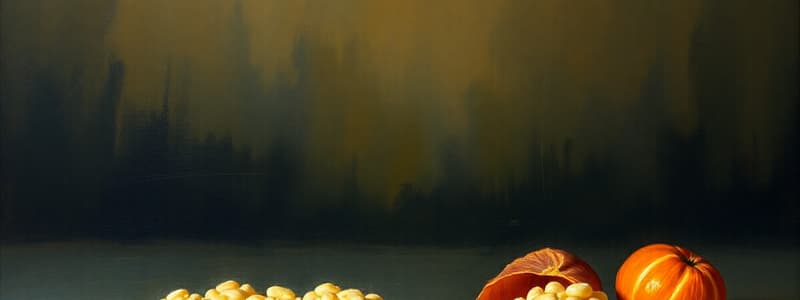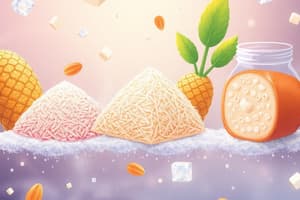Podcast
Questions and Answers
What are carbohydrates primarily composed of?
What are carbohydrates primarily composed of?
Carbon, hydrogen, and oxygen atoms
Which of the following is NOT a type of carbohydrate?
Which of the following is NOT a type of carbohydrate?
- Monosaccharides
- Disaccharides
- Lipids (correct)
- Polysaccharides
Starch releases energy faster than sugar.
Starch releases energy faster than sugar.
False (B)
What is the caloric value of 1g of carbohydrate?
What is the caloric value of 1g of carbohydrate?
What is the primary function of carbohydrates in the body?
What is the primary function of carbohydrates in the body?
Monosaccharides are the simplest form of carbohydrates and include glucose, fructose, and ______.
Monosaccharides are the simplest form of carbohydrates and include glucose, fructose, and ______.
What process do plants use to produce carbohydrates?
What process do plants use to produce carbohydrates?
Match the following types of carbohydrates with their examples:
Match the following types of carbohydrates with their examples:
Eating sugary foods regularly can contribute to dental caries.
Eating sugary foods regularly can contribute to dental caries.
What is the effect of low carbohydrate intake on blood sugar?
What is the effect of low carbohydrate intake on blood sugar?
What is the term for sugars that are naturally occurring in foods?
What is the term for sugars that are naturally occurring in foods?
What happens when the body runs low on carbohydrates?
What happens when the body runs low on carbohydrates?
What are NMES in relation to carbs?
What are NMES in relation to carbs?
What is the process of breaking down starch into smaller glucose molecules called?
What is the process of breaking down starch into smaller glucose molecules called?
At what temperature does caramel ideally form?
At what temperature does caramel ideally form?
Dextrinisation occurs when food is cooked by dry heat.
Dextrinisation occurs when food is cooked by dry heat.
What are the sensory changes associated with dextrinisation?
What are the sensory changes associated with dextrinisation?
Which cooking methods can cause dextrinisation?
Which cooking methods can cause dextrinisation?
What is caramelisation?
What is caramelisation?
The initial product of caramelisation is a syrup derived from _____ (type of sugar).
The initial product of caramelisation is a syrup derived from _____ (type of sugar).
Match the stages of gelatinisation with their temperatures:
Match the stages of gelatinisation with their temperatures:
Flashcards
Carbohydrates
Carbohydrates
Essential nutrients for energy, made of carbon, hydrogen, and oxygen, found in various foods.
Monosaccharides
Monosaccharides
Simplest form of carbohydrates, including glucose, fructose, and galactose.
Glucose
Glucose
A simple sugar used by the body for energy, found in many fruits and vegetables.
Fructose
Fructose
Signup and view all the flashcards
Galactose
Galactose
Signup and view all the flashcards
Disaccharides
Disaccharides
Signup and view all the flashcards
Sucrose
Sucrose
Signup and view all the flashcards
Lactose
Lactose
Signup and view all the flashcards
Maltose
Maltose
Signup and view all the flashcards
Polysaccharides
Polysaccharides
Signup and view all the flashcards
Starch
Starch
Signup and view all the flashcards
Cellulose
Cellulose
Signup and view all the flashcards
Pectin
Pectin
Signup and view all the flashcards
Glycemic Index (GI)
Glycemic Index (GI)
Signup and view all the flashcards
Dextrinization
Dextrinization
Signup and view all the flashcards
Caramelization
Caramelization
Signup and view all the flashcards
Gelatinization
Gelatinization
Signup and view all the flashcards
Low GI
Low GI
Signup and view all the flashcards
High GI
High GI
Signup and view all the flashcards
Study Notes
Carbohydrates
- Essential macronutrients providing energy
- Composed of carbon, hydrogen, and oxygen
- Made by photosynthesis
- Two main types: starch and sugar
- Starch produces slower releasing energy than sugar and has a lower GI (glycaemic index)
- Found in grains, potatoes, fruits, vegetables, and dairy products
- Classified into monosaccharides, disaccharides, and polysaccharides
- 1g of carbohydrate produces 4 kcals of energy, the same as protein
Monosaccharides
- Simplest form of carbohydrates
- Examples: glucose, fructose, and galactose
Glucose
- Simple sugar used by the body for energy
- Found in many fruits and vegetables, both fresh and dried
- Present in sugar cane, sugar beet, corn, and honey
Fructose
- Naturally occurring sugar found in fruits and honey
Galactose
- Sugar that combines with glucose to form lactose
- Found in milk and milk products, as well as honey and avocados
Disaccharides
- Formed by the joining of two monosaccharides
- Types: sucrose, lactose, and maltose
Sucrose
- Composed of glucose and fructose
- Major source: sugar cane and sugar beet
- Common ingredient in processed foods
Lactose
- Naturally found in milk, key nutrient for infants
- Also found in dairy products like cheese and yogurt
Maltose
- Found in plant foods like sweet potatoes, soybeans, barley, and wheat
- Product of starch breakdown
Polysaccharides
- Complex carbohydrates made up of many monosaccharide molecules
- Examples: starch, cellulose, pectin
Starch
- Storage form of carbohydrates found in plants
- Good sources: potatoes, bread, rice, pasta
- Classified as a slow release carbohydrate, provides a steady release of energy
Cellulose
- Found in the cell walls of plants
- Not digestible by humans, considered dietary fiber
Pectin
- Found in the cell walls of fruits
- Soluble fibre used as a gelling agent in jams and jellies
Effects of Carbohydrate Intake
- Too Few Carbohydrates:
- Low blood sugar
- Fat burning
- Protein breakdown
- Too Many Carbohydrates:
- Fat storage
- Weight gain
- Liver disease
- Heart disease
Glycemic Index (GI)
- Ranking system for how carbohydrates affect blood sugar levels
- Measures how quickly different carbohydrate foods raise blood sugar levels
- High GI: Faster digestion, quicker rise in blood sugar
- Low GI: Slower digestion, slower rise in blood sugar
Dextrinisation
- Occurs when starches are subjected to dry heat (baking, grilling, toasting)
- Breaks down starch molecules into smaller glucose molecules called dextrin
- Causes changes in color, smell, and texture
- Burnt toast is an example of dextrinisation with carbon as a result of heat driven off hydrogen and oxygen
Caramelisation
- Process of heating sucrose (sugar)
- Results in changes to texture, taste, and color
- Sucrose melts, forms a syrup, then boils
- As sucrose breaks down, water evaporates, leading to colour changes from colorless to golden brown to dark brown to black
- Taste profile changes from sweet to toffee to caramel to bitter
- Texture changes from sugar crystals to syrup to brittle toffee
- Ideal temperature for caramelisation is 160-170°C
- Stirring during caramelisation can lead to large, hard lumps
- Foods containing natural sugar (like onions) will caramelize when sautéed or roasted
Gelatinisation
- Process of heating starch in a liquid
- Starch granules absorb water, swell, and burst
- Starch molecules release into the liquid, forming a 3-dimensional network that traps water molecules
- Results in thickening of the liquid and formation of a gel when cooled
- Occurs during cooking of foods containing starch
- Changes the liquid from transparent to opaque as starch is released
- Temperature ranges from 60°C to 100°C
- Regular stirring prevents lumps by ensuring even distribution of starch granules
Studying That Suits You
Use AI to generate personalized quizzes and flashcards to suit your learning preferences.




